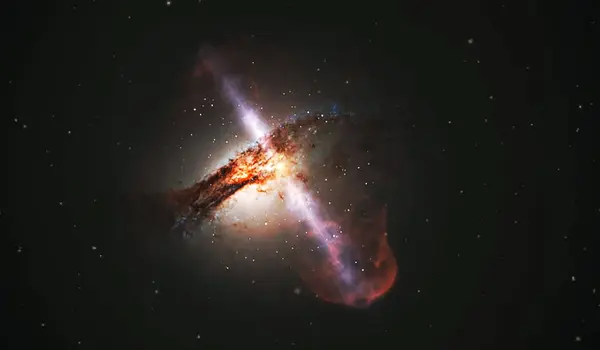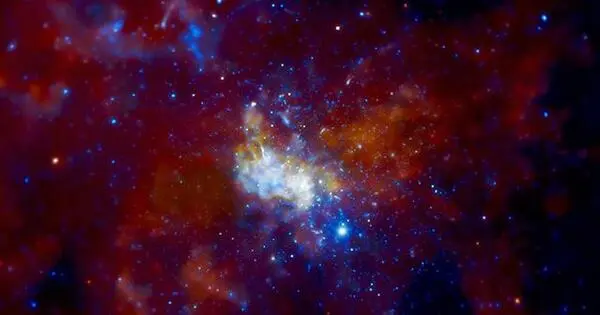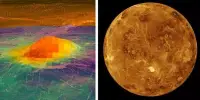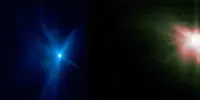Black holes pose a challenge in the early universe. We know that some black holes grew to be a billion times the mass of the sun just one billion years after the Big Bang based on observations from telescopes on Earth and in space. Our current models of black hole growth, however, cannot account for this rate of expansion. So, how did these massive black holes form?
An invisible layer surrounds black holes, swallowing all traces of their past. Machine learning and supercomputers are now being used by researchers to reconstruct the growth histories of black holes.
Whatever their differences, black holes and Las Vegas have one thing in common: what happens there stays there, much to the chagrin of astrophysicists trying to understand how, when, and why black holes form and grow. Black holes are surrounded by a mysterious, invisible layer called the event horizon, from which nothing, not matter, light, or information, can escape. The event horizon consumes all evidence of the black hole’s past.
“Because of these physical facts, it was thought impossible to measure how black holes formed,” said Peter Behroozi, an associate professor at the University of Arizona Steward Observatory and a project researcher at the National Astronomical Observatory of Japan.
Together with Haowen Zhang, a doctoral student at Steward, Behroozi led an international team to use machine learning and supercomputers to reconstruct the growth histories of black holes, effectively peeling back their event horizons to reveal what lies beyond.
We have very good observations of black hole masses. However, those are largely restricted to the local universe. As you look farther away, it becomes increasingly difficult, and eventually impossible, to accurately measure the relationships between the masses of black holes and their host galaxies.
Haowen Zhang
Simulations of millions of computer-generated “universes” revealed that supermassive black holes grow in lockstep with their host galaxies. This had been suspected for 20 years, but scientists had not been able to confirm it until now. The team’s findings were published in Monthly Notices of the Royal Astronomical Society.
“If you go back to earlier and earlier times in the universe, you find that exactly the same relationship was present,” said Behroozi, a co-author on the paper. “As the galaxy grows from small to large, its black hole grows from small to large, exactly as we see in galaxies today all across the universe.”
Most, if not all, galaxies scattered throughout the cosmos are thought to harbor a supermassive black hole at their center. These black holes pack masses greater than 100,000 times that of the sun, with some boasting millions, even billions of solar masses. One of astrophysics’ most vexing questions has been how these behemoths grow as fast they do, and how they form in the first place.
To find answers, Zhang, Behroozi, and their colleagues developed Trinity, a platform that employs a novel type of machine learning capable of generating millions of different universes on a supercomputer, each of which adheres to different physical theories about how galaxies should form. The researchers created a framework in which computers propose new rules for the evolution of supermassive black holes over time. They then used those rules to simulate the growth of billions of black holes in a virtual universe and “observed” the virtual universe to see if it agreed with decades of real-world observations of black holes. The computers settled on rules that best described existing observations after millions of proposed and rejected rule sets.

“We’re trying to understand the rules of how galaxies form,” Behroozi said. “In a nutshell, we make Trinity guess what the physical laws may be and let them go in a simulated universe and see how that universe turns out. Does it look anything like the real one or not?”
This method, according to the researchers, works equally well for anything else inside the universe, not just galaxies.
The project’s name, Trinity, refers to its three main areas of study: galaxies, supermassive black holes, and dark matter halos – vast cocoons of dark matter that are invisible to direct measurements but whose existence is required to explain the physical properties of galaxies everywhere. In previous studies, the researchers used an earlier version of their framework, called the UniverseMachine, to simulate millions of galaxies and their dark matter halos. The team discovered that galaxies growing in their dark matter halos follow a very specific relationship between the mass of the halo and the mass of the galaxy.
“In our new work, we added black holes to this relationship,” Behroozi said, “and then asked how black holes could grow in those galaxies to reproduce all the observations people have made about them.”
“We have very good observations of black hole masses,” said Zhang, the paper’s lead author. “However, those are largely restricted to the local universe. As you look farther away, it becomes increasingly difficult, and eventually impossible, to accurately measure the relationships between the masses of black holes and their host galaxies. Because of that uncertainty, observations can’t directly tell us whether that relationship holds up throughout the universe.”
Trinity enables astrophysicists to overcome not only that limitation but also the event horizon information barrier for individual black holes by combining data from millions of observed black holes at various stages of growth. Even though no single black hole’s history could be reconstructed, the researchers were able to calculate the average growth history of all black holes combined.
“You can compare the resulting universe to all the observations of actual black holes that we have if you put black holes into the simulated galaxies and enter rules about how they grow,” Zhang said. “We can then reconstruct how any black hole or galaxy in the universe looked from today all the way back to the beginning of time.”
Another perplexing phenomenon was illuminated by the simulations: Supermassive black holes, such as the one found at the center of the Milky Way, grew most rapidly during their infancy, when the universe was only a few billion years old, only to slow dramatically over the next 10 billion years or so.
“We’ve known for a long time that galaxies have this strange behavior in which they reach a peak in their rate of forming new stars, then it dwindles over time, and then they stop forming stars entirely,” Behroozi explained. “Now, we’ve been able to show that black holes do the same: growing and shutting off at the same times as their host galaxies. This confirms a decades-old hypothesis about black hole growth in galaxies.”
However, the outcome raises more questions, he adds. Black holes are much smaller than the galaxies they inhabit. The supermassive black hole in the Milky Way would be the size of the period at the end of this sentence if it were scaled down to the size of Earth. To double in mass within the same timeframe as the larger galaxy, gas flows at vastly different scales must be synchronized. It is unknown how black holes and galaxies collaborate to achieve this balance.














